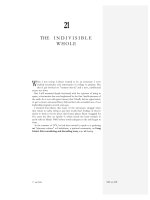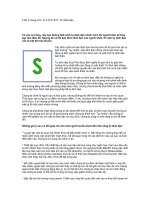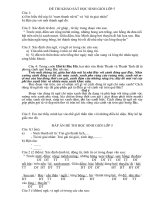THE I N D I V I S I B L E WHOLE
Bạn đang xem bản rút gọn của tài liệu. Xem và tải ngay bản đầy đủ của tài liệu tại đây (637.73 KB, 70 trang )
17. září 2004
343 ze 412
21
THE I N D I V I S I B L E
WHOLE
hen I was young I always wanted to be an astronaut. I even
studied aeronautics and astronautics in college to prepare. But
then I got hooked on "systems theory" and a new, earthbound
career was born.
But I still remained deeply fascinated with the
experience
of being in
space, a fascination that was heightened by the first Apollo pictures of
the earth. So it was with great interest that I finally had an opportunity
to get to know astronaut Rusty Schweickart who attended one of our
leadership programs several years ago.
I learned from Rusty that many of the astronauts struggle when
they return to earth, trying to put into words their feelings of what it
meant to them to hover above their home planet. Rusty struggled for
five years (he flew on Apollo 9, which tested the lunar module in
earth orbit in March 1969) before words adequate to the task began to
form.
In the summer of 1974, he had been invited to speak to a gathering
on "planetary culture" at Lindisfarne, a spiritual community on Long
Island. After considering and discarding many ways of sharing
W
17. září 2004
344 ze 412
his experience he realized that he couldn't tell it as
his
story. Because
it was
our
story. He realized that he and the other astronauts
represented an "extension of the sensory apparatus of the human
species. Yes, I was looking out from my eyes and feeling with my
senses but it was also our eyes and our senses. We who were the first
to leave and look back at the earth were looking back for all of
humankind. Though there were only a few of us, it was our respon-
sibility to report back what we experienced." Realizing this, he decided
simply to describe what it was like—as if you and I, the listeners,
were there as well.
1
Up there you go around every hour and a half, time after time after
time. You wake up usually in the mornings. And just the way that the
track of your orbits go, you wake up over the Mideast, over North
Africa. As you eat breakfast you look out the window as you're
going past and there's the Mediterranean area, and Greece, and
Rome, and North Africa, and the Sinai, the whole area. And you
realize in one glance that what you're seeing is what was the whole
history of man for years—the cradle of civilization. And you think
of all the history you can imagine looking at that scene.
And you go around down across North Africa and out over the
Indian Ocean, and look up at that great sub-continent of India
pointed down toward you as you go past it. And Ceylon off to the
side, Burma, Southeast Asia, out over the Philippines, and up
across that monstrous Pacific Ocean, vast body of water—you've
never realized how big that is before. And you finally come up
across the coast of California and look for those friendly things: Los
Angeles, and Phoenix, and on across El Paso and there's Houston,
there's home, and you look and sure enough there's the Astrodome.
And you identify with that, you know—it's an attachment.
And down across New Orleans and then looking down to the
south and there's the whole peninsula of Florida laid out. And all
the hundreds of hours you spent flying across that route, down in
the atmosphere,.all that is friendly again. And you go out across the
Atlantic Ocean and back across Africa.
And that identity—that you identify with Houston, and then you
identify with Los Angeles and Phoenix and New Orleans and
everything. And the next thing you recognize in yourself, is you're
identifying with North Africa. You look forward to that, you antic-
ipate it. And there it is. That whole process begins to shift what it
17. září 2004
345 ze 412
is you identify with. When you go around it in an hour and a half
you begin to recognize that your identity is with the whole thing.
And that makes a change.
You look down there and you can't imagine how many borders
and boundaries you crossed again and again and again. And you
don't even see 'em. At that wake-up scene—the Mideast—you
know there are hundreds of people killing each other over some
imaginary line that you can't see. From where you see it, the thing is
a whole, and it's so beautiful. And you wish you could take one from
each side in hand and say, "Look at it from this perspective. Look at
that. What's important?"
And so a little later on, your friend, again those same neighbors,
the person next to you goes to the moon. And now he looks back
and sees the Earth not as something big where he can see the
beautiful details, but he sees the Earth as a small thing out there.
And now that contrast between the bright blue and white Christmas
tree ornament and that black sky, that infinite universe, really comes
through.
The size of it, the significance of it—it becomes both things, it
becomes so small and so fragile, and such a precious little spot in the
universe, that you can block it out with your thumb, and you realize
that on that small spot, that little blue and white thing is everything
that means anything to you. All of history and music, and poetry
and art and war and death and birth and love, tears, joy, games, all
of it is on that little spot out there that you can cover with your
thumb.
And you realize that that perspective . . . that you've changed,
that there's something new there. That relationship is no longer
what it was. And then you look back on the time when you were
outside on the EVA [extravehicular activity] and those few mo-
ments that you had the time because the camera malfunctioned,
that you had the time to think about what was happening. And you
recall staring out there at the spectacle that went before your eyes.
Because now you're no longer inside something with a window
looking out at the picture, but now you're out there and what
you've got around your head is a goldfish bowl and there are no
boundaries. There are no frames, there are no boundaries.
Floating in space, Rusty discovered the first principles of systems
thinking. But he discovered them in a way that few of us ever do—
not at a rational or intellectual level but at a level of direct experi-
17. září 2004
346 ze 412
ence. The earth is an indivisible whole, just as each of us is an
indivisible whole. Nature (and that includes us) is not made up of
parts within wholes. It is made up of wholes within wholes. All
boundaries, national boundaries included, are fundamentally arbitrary.
We invent them and then, ironically, we find ourselves trapped within
them.
But there was something more. In the years following that first
talk at Lindisfarne, Rusty found himself drawn into a whole new
series of insights and personal changes. He found himself drawn into
new work, leaving his post as commissioner of the California Energy
Commission and becoming more active in joint projects involving
U.S. astronauts and Soviet cosmonauts.
2
He listened and learned
about others' experience. He began to involve himself in activities
that seemed congruent with his new understandings.
One that had a special impact was learning about the "Gaia"
hypothesis—the theory that the biosphere, all life on earth, is itself a
living organism.
3
This idea, which has deep roots in many prein-
dustrial cultures, such as American Indian cultures, "struck a deep
chord in me," says Rusty. "For the first time it gave the scientist in me
a way to talk about aspects of my experience in space that I couldn't
even articulate to myself. I had experienced the earth in a way that I
had no way to describe. I had experienced the aliveness of it—of it
all."
At the conclusion of the leadership workshop, someone asked
spontaneously, "Rusty, tell us what it was like up there?" He
paused for a long time. When he finally spoke, he said only one
thing. "It was like seeing a baby about to be born."
Something new is happening. And it has to do with it all—the
whole.
17. září 2004
348 ze 412
APPENDIX 1:
THE LEARNING
DISCIPLINES
Each of the five learning disciplines can be thought of on
three distinct levels:
•
practices: what you do
•
principles: guiding ideas and insights
•
essences: the state of being of those with high levels of
mastery in the
discipline
The practices are activities upon which practitioners of the
discipline focus their time and energy. For example, systems
thinking entails using the "systems archetypes" in order to
perceive underlying structures in complex situations. Personal
mastery entails "clarifying personal vision," and "holding
creative tension," simultaneously focusing on the vision and cur-
rent reality and allowing the tension between the two to generate
energy toward achieving the vision. Working with mental models
involves distinguishing the direct "data" of experience from the
generalizations or abstractions that we form based on the data.
The practices are the most evident aspect of any discipline.
They are also the primary focus of individuals or groups when
they begin to follow a discipline. For the beginner, they require
"discipline" in the sense of con-
17. září 2004
349 ze 412
scious and consistent effort because following the practices is
not yet second
nature. In a heated debate, the novice at
working
with mental models
will have to make an effort to identify the
assumptions he is making
and
why. Often the beginner's efforts
in a discipline are characterized by time displacement: only
after
the debate, does one see one's assumptions clearly and
distinguish them from the "data" and reasoning upon which they
are based. However, eventually, the practices of a discipline
become more and more automatic and active in "real time." You
find yourself spontaneously thinking of systems archetypes, re-
creating (which is different from recalling) your vision, and
recognizing your assumptions as they come into play, while
confronting pressing problems.
Equally central to any discipline are the underlying principles.
These represent the theory that lies behind the practices of the
disciplines. For example, "structure influences behavior" is a
central principle underlying systems thinking, as is "policy
resistance," the tendency of complex systems to resist efforts to
change their behavior. The former implies that the ability to
influence reality comes from seeing structures that are controlling
behavior and events. The latter implies that efforts to manipulate
behavior, for example through well-intentioned programs such as
building new houses for disadvantaged urban dwellers, will
generally improve matters only in the short run and often lead to
still more problems in the long run. Similarly, the power of vision
is a principle of personal mastery, as is the distinction between
"creative tension" and "emotional tension."
The principles behind a discipline are important to the beginner
as well as to the master. For the beginner, they help him in
understanding the rationale behind the discipline and in making
sense of the practices of the discipline. For the master, they are
points of reference which aid in continually refining the practice
of the discipline and in explaining it to others.
It is important to recognize that mastering any
of
the disciplines
requires effort on both the levels of understanding the principles
and
following the practices. It is tempting to think that just
because one understands certain principles one has "learned"
about the discipline. This is the familiar trap of confusing
intellectual understanding with learning. Learning always involves
new understandings and new behaviors, "thinking" and
"doing." This is the reason for distinguishing principles from
practices. Both are vital.
The third level, the "essences" of the disciplines, is different.
There is no point in focusing one's conscious attention and
effort on these essences in learning a discipline, any more than it
would make sense to
make an effort
to experience love or joy or
tranquillity. The essences of the disciplines are the
state of being
that comes to be experienced naturally by individuals or groups
with high levels of mastery in the disciplines. While these are
difficult to express in words, they are vital to grasp fully the
meaning and purpose of each discipline. Each of the disciplines
alters its
17. září 2004
350 ze 412
practitioner in certain very basic ways. This is why we refer to them as personal
disciplines, even those that must be practiced collaboratevely.
For example, systems thinking leads to experiencing more and more of the
interconnectedness of life and to seeing wholes rather than parts. Whenever
there are problems, in a family or in an organization, a master of systems
thinking automatically sees them as arising from underlying structures rather
than from individual mistakes or ill will. Likewise, personal mastery leads to
an increased sense of "beingness," awareness of the present moment, both
what is happening within us and outside of us, and to heightened experience
of "generativeness," of being part of the creative forces shaping one's life.
At the level of essences, the disciplines start to converge. There is a
common sensibility uniting the disciplines—the sensibility of being learners in
an intrinsically interdependent world. Yet, there are still differences between
the disciplines. But the differences become increasingly subtle. For example,
"interconnectedness" (systems thinking) and "connectedness" (personal
mastery) are subtle distinctions. The former has to do with awareness of how
things interrelate to one another; the latter with awareness of being part of
rather than apart from the world. So, too, is the distinction between
"commonality of purpose" (shared vision) and "alignment" (team learning) a
fine one. While the former has to do with a common direction and reason
for being, the latter has to do with "functioning as a whole" when we
actually work together. Though subtle, these distinctions are important. Just as
the connoisseur of fine wines makes distinctions that the novice would not,
so do individuals and groups who develop high levels of mastery in the
disciplines see distinctions that might be obscure to beginners.
Lastly, the disciplines of building shared vision and team learning differ
from the other three in that they are inherently collective in nature. The
practices are activities engaged in by groups. The principles must be under-
stood by groups. And the essences are states of being experienced collec-
tively.
17. září 2004
351 ze 412
17. září 2004
352 ze 412
One
does not master a discipline all at once.
There are distinct
stages of
learning that we all go through. Diana Smith has
devised
a
three-stage continuum
for developing new capacities
that is helpful in approaching
all the
learning disciplines:
Stage Three: Values and Operating
Assumptions
People can string together rules that reflect
new action values and operating assumptions.
They can
enact
these rules under stress and
ambiguity, continuing
to
aid their own and
others' learning. By this stage, people will have
adapted the rules into their own particular
model, speaking in their own voice.
Stage Two: New Action Rules
As old assumptions "loosen" in response to
the cognitive insights of Stage One, people
begin to experiment with action rules based on
new assumptions so they can see what they
yield. They may need to rely on the new
language to produce new actions, and they will
find it difficult to access or string together new
rules when under stress.
Stage
One:
New Cognitive Capacities People see
new things and can speak a new language. This
allows them to see more clearly their own and
others' assumptions, actions, and
consequences of both. Typically, they find it
hard to translate these new cognitive and
linguistic competencies into fundamentally new
actions. They may begin to behave differently,
but the basic rules, assumptions, and values are
the same.
17. září 2004
353 ze 412
APPENDIX 2:
SYSTEMS
ARCHETYPES
1
BALANCING PROCESS
WITH DELAY
Structure:
Description:
A person, a group, or an organization, acting
toward a goal, adjusts their behavior in response to delayed
feedback. If they are not conscious of the delay, they end up
taking more corrective action than needed, or (sometimes) just
giving up because they cannot see that any progress is being
made.
17. září 2004
354 ze 412
Early Warning Symptom: "We
thought
we
were
in balance, but
then we
overshot the mark." (Later, you may overshoot in the
other direction again.)
Management Principle:
In a sluggish system, aggressiveness
produces instability. Either be patient or make the system more
responsive.
Business Story:
Real estate developers keep building new
properties until the market has gone soft—but, by then, there are
already enough additional properties still under construction to
guarantee a glut.
Other Examples:
A shower where the hot water responds
sluggishly to changes in the faucet positions;
production/distribution glut and shortage cycles (such as that of
the beer game); cycles in production rates and in-process
inventory due to long manufacturing cycle times; the Tiananmen
Square massacre, in which the government delayed its reaction
to protest, and then cracked down unexpectedly hard; sudden,
excessive stock market soars and crashes.
LIMITS TO GROWTH
Structure:
Description:
A process feeds on itself to produce a period of
accelerating growth or expansion. Then the growth begins to slow
(often inexplicably to the participants in the system) and
eventually comes to a halt, and may even reverse itself and begin
an accelerating collapse.
The growth phase is caused by a reinforcing feedback process
(or by several reinforcing feedback processes). The slowing arises
due to a balancing process brought into play as a "limit" is
approached. The limit can be a resource constraint, or an external
or internal response to growth. The accelerating collapse (when
it occurs) arises from the reinforcing process operating in
reverse, to generate more and more contraction.
Early Warning Symptom:
"Why should we worry about
problems we don't have? We're growing tremendously." (A little
later, "Sure there are some
17. září 2004
355 ze 412
problems, but all we have to do is go back to what was
working before."
Still later, "The
harder
we run, the
more we
seem to stay in the same place.")
Management Principle:
Don't push on the reinforcing (growth)
process, remove (or weaken) the source of limitation.
Business
Story: A company instituted an affirmative action
program, which grew in support and activity as well-qualified
minority employees were successfully introduced into work teams
throughout the company. But eventually resistance emerged; the
new staffers were perceived as not having "earned" their
positions over other qualified aspirants. The harder individual
teams were pressured to accept the new members, the more
they resisted.
Other
Examples: Learning a new skill, such as tennis, you make
rapid progress early on as your competence and confidence
builds, but then you begin to encounter limits to your natural
abilities that can be overcome only by learning new techniques
that may come "less naturally" at first.
A new startup that grows rapidly until it reaches a size that
requires more professional management skills and formal
organization; a new product team that works beautifully until its
success causes it to bring in too many new members who neither
share the work style nor values of the founding members; a city
that grows steadily until available land is filled, leading to rising
housing prices; a social movement that grows until it encounters
increasing resistance from "nonconverts"; an animal population
that grows rapidly when its natural predators are removed, only
to overgraze its range and decline due to starvation.
SHIFTING THE BURDEN
Structure:
17. září 2004
356 ze 412
Description:
A short-term "solution" is used to correct
a
problem, with
seemingly positive immediate results. As this
correction is used more
and
more, more fundamental long-term
corrective measures are used less
and
less. Over time, the
capabilities for the fundamental solution may atrophy or become
disabled, leading to even greater reliance on the symptomatic
solution.
Early Warning Symptom:
"Look here, this solution has worked so
far! What do you mean, there's trouble down that road?"
Management Principle:
Focus on the fundamental solution. If
symptomatic solution is imperative (because of delays in
fundamental solution), use it to gain time while working on the
fundamental solution.
Business Story:
A dramatic new circuit board technology can be
used to develop unique functionality and cost savings in a great
many new product applications, but it can also be substituted for
existing boards in current products. Salespeople can try to sell to
"specialty customers" who appreciate the special properties of the
technology and will eventually design new products which exploit
it fully (the "fundamental solution") or sell to "commodity
customers" who do not care about its special properties and will
simply substitute it for other boards (the "symptomatic
solution"). Given management pressures to meet quarterly sales
targets, salespeople sell to whoever is ready to buy, which usually
will be commodity customers since there are more of them and
delays in the selling cycle are shorter. Over time, the dramatic
new technology fails to develop a loyal customer base and
becomes subject to the price and margin pressures that
characterize commodity products.
Other Examples:
Selling more to existing customers rather than
broadening the customer base (The "ATP case" from Chapter
12); paying bills by borrowing, instead of going through the
discipline of budgeting; using alcohol, drugs, or even something
as benign as exercise to relieve work stress and thereby not
facing the need to control the workload itself; and any addiction,
anywhere, to anything.
17. září 2004
357 ze 412
One area where shifting the burden structures are so common
and so pernicious that it warrants special notice is when outside
"intervenors" try to help solve problems. The intervention
attempts to ameliorate obvious problem symptoms, and does so
so successfully that the people within the system never learn how
to deal with the problems themselves.
Management Principle:
"Teach people to fish, rather than giving
them fish." Focus on enhancing the capabilities of the "host
system" to solve its own problems. If outside help is needed,
"helpers" should be strictly limited to a one-time intervention
(and everyone knows this in advance) or be able to help people
develop their own skills, resources, and infrastructure to be
more capable in the future.
Business Story:
An innovative insurance company was
committed to the concept of independent local offices that
would call on headquarters staff only for occasional help. Initially
the concept worked well, until the industry went through a crisis.
Facing sudden severe losses, the local offices called in the more
experienced central management for help in rewriting rate
structures—a process which took months. Meanwhile, the local
managers focused their attention on managing the crisis. The
crisis was resolved, but the next time rate structures were called
into question, the local offices had lost some of their confidence.
They called in the central managers as "insurance." After several
years of this behavior, the local offices found themselves without
underwriters who could manage rate structure changes
independently.
SPECIAL CASE: SHIFTING THE
BURDEN TO THE INTERVENOR
Structure:
17. září 2004
358 ze 412
Other Examples:
Dependence on outside contractors instead
of
training your
own people. Numerous forms of government aid that
attempt to
solve pressing
problems only to foster dependency and need for
increasing aid:
welfare
systems that foster single-family
households; housing or job training programs that attract the
needy to cities with the best programs; food aid
to
developing
countries which lowers deaths and increases population growth;
social security systems that reduce personal savings and
encourage
the
breakup of the extended family.
ERODING GOALS
Structure:
Description:
A shifting the burden type of structure in which the
short-term solution involves letting a long-term, fundamental goal
decline.
Eariy Warning Symptom:
"It's okay if our performance
standards slide a little, just until the crisis is over."
Management Principle:
Hold the vision.
Business Story:
A high-tech manufacturer finds itself losing
market share, despite a terrific product and ongoing
improvements. But the firm, oriented toward its design
"geniuses," had never gotten production scheduling under
control. An outside investigator discovered that customers were
increasingly dissatisfied with late schedules, and were turning to
17. září 2004
359 ze 412
competitors instead. The company stood on its record: "We've
maintained a consistent 90 percent success in meeting the
delivery time quoted to the customer." It therefore looked
elsewhere for the problem. However, every time the company
begin to slip its schedules, it responded by making the quoted
delivery
17. září 2004
360 ze 412
time a little longer.
Thus, the quoted delivery time to customers
was getting
lengthier, and lengthier, and lengthier . . .
Other Examples: Successful
people who lower their own
expectations
for themselves
and gradually become less successful.
Firms that tacitly
lower their
quality standards by cutting budgets
rather than investing in developing new higher quality (and
perhaps lower cost) ways of doing things, all
the
while proclaiming
their continued commitment to quality. Lowered government
targets for "full employment" or balancing the federal deficit.
Sliding targets for controlling dangerous pollutants or
protecting endangered species.
ESCALATION
Structure:
2
Description:
Two people or organizations each see their welfare
as depending on a relative advantage over the other. Whenever
one side gets ahead, the other is more threatened, leading it to act
more aggressively to reestablish its advantage, which threatens
the first, increasing its aggressiveness, and so on. Often each side
sees its own aggressive behavior as a defensive response to the
other's aggression; but each side acting "in defense" results in a
buildup that goes far beyond either side's desires.
Early Warning Symptom:
"If our opponent would only slow
down, then we could stop fighting this battle and get some other
things done."
Management Principle:
Look for a way for both sides to
"win," or to achieve their objectives. In many instances, one
side can unilaterally reverse the vicious spiral by taking overtly
aggressive "peaceful" actions that cause the other to feel less
threatened.
Business Story:
A company developed an ingenious design for a
stroller, which carried three toddlers at once, yet was light and
convenient for travel. It was an immediate hit with families with
several young children. Almost
17. září 2004
361 ze 412
simultaneously, a competitor emerged with a similar product.
After several years, jealous of the other company's share of the
market, the first company lowered its price by 20 percent. The
second company felt a decline in sales, and lowered its price too.
Then the first company, still committed to boosting share,
lowered its prices still further. The second company reluctantly
did the same, even though its profits were beginning to suffer.
Several years later, both companies were barely breaking even,
and survival of the triple carriage was in doubt.
Other Examples: Advertising wars. Increasing reliance on lawyers
to settle disputes. Gang warfare. The breakup of a marriage.
Inflating budget estimates: as some groups inflate their estimates,
others find themselves doing likewise in order to get "their piece
of the pie," which leads to everyone inflating his estimates still
further. Battle for the "ear" of the president of a company. And,
of course, the arms race.
SUCCESS TO THE
SUCCESSFUL
Structure:
Description: Two activities compete for limited support or
resources. The more successful one becomes, the more support
it gains, thereby starving the other.
Early Warning Symptom: One of the two interrelated activities,
groups, or individuals is beginning to do very well and the other is
struggling.
Management Principle: Look for the overarching goal for
balanced achievement of both choices. In some cases, break or
weaken the coupling between
17. září 2004
362 ze 412
the two, so that they do not compete for the same limited
resource (this is desirable in cases where the coupling is
inadvertent and creates an unhealthy competition for
resources).
Business Story: A manager has two proteges, and wishes to bring
both along equally in the firm. However, one of the two ends up
getting preferential treatment because the other is out sick for a
week. When the second protege returns to work, the manager
feels guilty, and avoids the person, thereby giving still more
opportunity to the first protege. The first protege\ feeling the
approval, flourishes, and therefore gets more opportunity. The
second protege, feeling insecure, does less effective work and
receives even fewer opportunities, although the two people had
equal ability in the beginning. Eventually, the second prate" g6
leaves the firm.
Other examples: Balancing home and work life, in which a
worker gets caught working overtime so much that relationships
at home deteriorate and it gets more and more "painful" to go
home, which, of course, makes the worker even more likely to
neglect home life in the future. Two products compete for limited
financial and managerial resources within a firm; one is an
immediate hit in the marketplace and receives more investment,
which depletes the resources available to the other, setting in
motion a reinforcing spiral fueling growth of the first and starving
the second. A shy student gets off to a poor start in school
(perhaps because of emotional problems or an undetected
learning disability), becomes labeled a "slow learner," and gets
less and less encouragement and attention than his or her more
outgoing peers.
17. září 2004
363 ze 412
TRAGEDY OF
THE COMMONS
Structure:
Description: Individuals use a commonly available but limited
resource solely on the basis of individual need. At first they are
rewarded for using it; eventually, they get diminishing returns,
which causes them to intensify their efforts. Eventually, the
resource is either significantly depleted, eroded, or entirely used
up.
Early Warning Symptom: "There used to be plenty for
everyone. Now things are getting tough. If I'm going to get any
profit out of it this year, I'll have to work harder."
Management Principle: Manage the "commons," either through
educating everyone and creating forms of self-regulation and peer
pressure, or through an official regulating mechanism, ideally
designed by participants.
Business Story: Several divisions of a company agreed to share a
retail salesforce. Each district manager was initially concerned
that the shared salesforce wouldn't give enough attention to his
or her particular business, and that volume would decline. One
particularly
aggressive
manager ad-
17. září 2004
364 ze 412
vised all his account managers to set higher sales targets than
were truly needed, so that the salesforce would at least
give
them the minimum support
they needed. The other divisions
saw this division pushing for extra work, and decided to employ
the same strategy. The new salesforce's managers wanted to
accommodate all of their "clients," so they continued to accept
the higher requests from the divisions. This created a
tremendous overburden of work, lowered performance, and
increased turnover. Pretty soon, joining the retail salesforce was
only slightly more popular than joining the French Foreign
Legion, and each division had to go back to maintaining its own
salesforce.
Other Examples:
Exhaustion of a shared secretarial pool.
Deteriorating reputation for customer service after customers
have had to listen to six different salespeople from six different
divisions of the same corporation pitching competing products.
(The "shared resource" in this case was the firm's positive
customer reputation.) A highly successful retail chain gives up on
joint sales promotions with manufacturers after being deluged
with proposals by enthusiastic manufacturers, or establishes
terms for joint ventures that leave little profit for the
manufacturers. Depletion of a natural resource by competing
companies which mine it. And, of course, all manner of pollution
problems from acid rain to ozone depletion and the
"greenhouse effect."
FIXES THAT FAIL
Structure:
Description:
A fix, effective in the short term, has unforeseen
long-term consequences which may require even more use of
the same fix.
Early
Warning Symptom: "It always seemed to work before;
why isn't it working now?"
17. září 2004
365 ze 412
Appendix 2: Systems Archetypes
Management Principle: Maintain focus on the long term.
Disregard short-term "fix," if feasible, or use it only to "buy
time" while working on long-term remedy.
Business Story: A manufacturing company launched a new set of
high-performance parts, which were wildly successful at first.
However, the CEO was driven by maximizing his ROI, so he
deferred ordering expensive, new production machines.
Manufacturing quality suffered, which led to a reputation for low
quality. Customer demand fell off dramatically over the ensuing
year, which depressed returns and made the CEO even more un-
willing to invest in new production equipment.
Other Examples: People and organizations who borrow to pay
interest on other loans, thereby ensuring that they will have to
pay even more interest later. Cutting back maintenance schedules
to save costs, which eventually leads to more breakdowns and
higher costs, creating still more cost-cutting pressures.
GROWTH AND
UNDERINVESTME
NT
Structure:
Description: Growth approaches a limit which can be eliminated
or pushed into the future if the firm, or individual, invests in
additional "capacity." But the investment must be aggressive and
sufficiently
rapid
to forestall reduced growth, or else it will
never get
made. Oftentimes, key
goals or
17. září 2004
366 ze 412
performance standards are lowered to justify underinvestment.
When this happens, there is a self-fulfilling prophecy where
lower goals lead to lower expectations,
which are then borne
out by poor performance caused by underinvestment. (This is
the Wondertech structure described in Chapter 7.)
Early Warning Symptom:
"Well, we used to be the best, and
we'll be the best again, but right now we have to conserve our
resources and not over-invest."
Management Principle:
If there is a genuine potential for growth,
build capacity in advance of demand, as a strategy for creating
demand. Hold the vision, especially as regards assessing key
performance standards and evaluating whether capacity to meet
potential demand is adequate.
Business Story:
As described in Chapter 8, the People Express
Airlines, found itself unable to build service capacity to keep pace
with exploding demand. Rather than putting more resources into
training or growing more slowly (for example, through raising
prices somewhat), the firm tried to "outgrow" its problems. The
result was deteriorating service quality and increased competition,
while morale deteriorated. In order to keep up with the
continued stress, the company relied more and more on the
"solution" of underinvesting in service capacity, until customers
no longer found flying People Express attractive.
Other Examples:
Companies which let service quality or product
quality of any sort decline, simultaneously blaming competition or
their sales management for not pushing hard enough to maintain
sales. People with grand visions who never realistically assess the
time and effort they must put in to achieve their visions.
17. září 2004
367 ze 412
NOTES
CHAPTER 1
" G I V E ME A LEVER LONG
ENOUGH...AND SINGLE-HANDED I
CAN MOVE THE WORLD"
1.
Daniel Yankelovich,
New Rules: Searching for Self-fulfillment in
a
World Turned Upside Down
(New York: Random House), 1981.
2.
I am indebted to my MIT colleague Alan Graham for the
insight that
basic innovation occurs through the integration of diverse
technologies
into a new ensemble. See A. K. Graham, "Software Design:
Breaking
the Bottleneck,"
IEEE Spectrum
(March 1982): 43-50; A. K.
Graham
and P. Senge, "A Long-Wave Hypothesis of Innovation,"
Technologi
cal Forecasting and Social Change
(1980): 283-311.
3.
Arie de Geus, "Planning as Learning,"
Harvard Business
Review
(March/April 1988): 70-74.
CHAPTER 2
DOES YOUR ORGANIZATION
HAVE A LEARNING
DISABILITY?
1. Arie de Geus, "Planning as Learning,"
Harvard Business
Review
(March/April 1988): 70-74.









